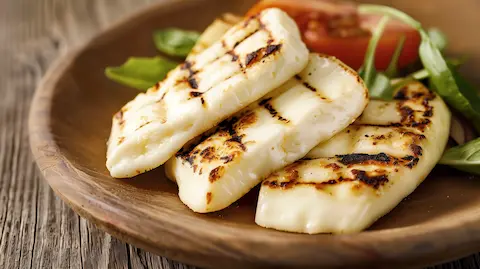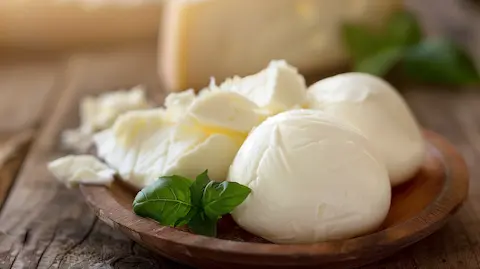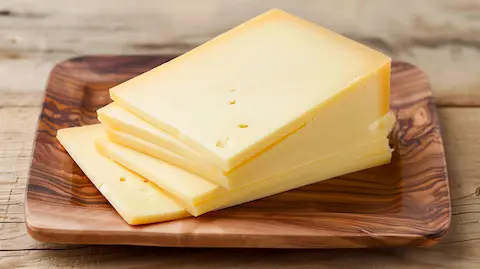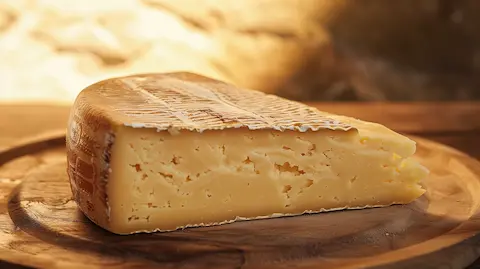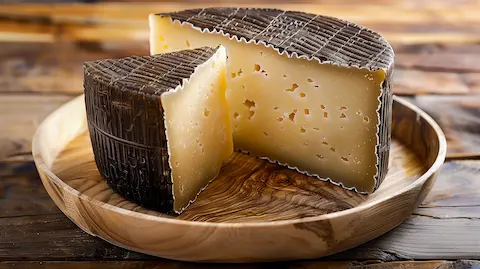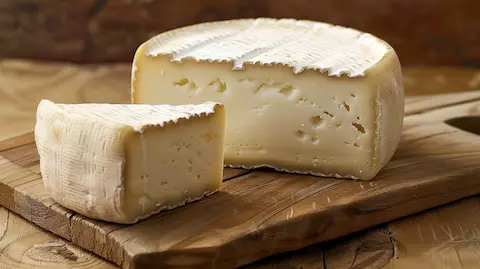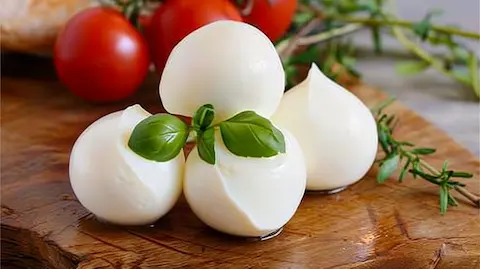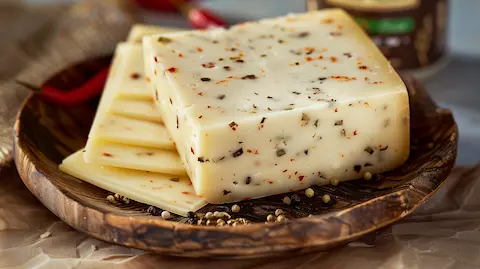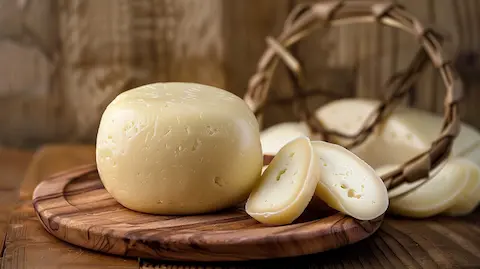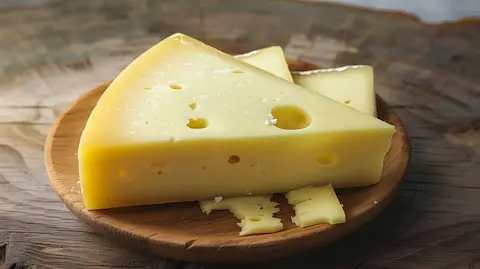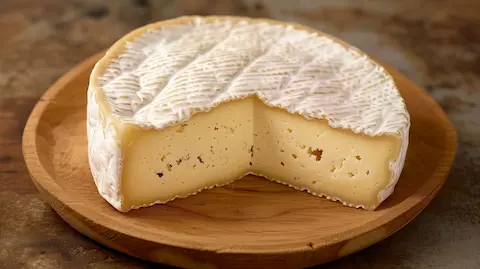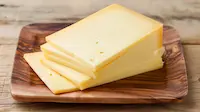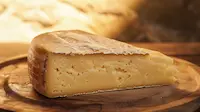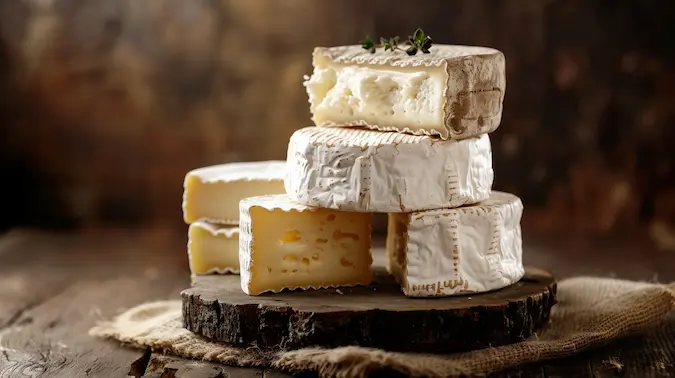Semi-Soft Cheese
Semi Soft Cheese is a category of cheese distinguished by its high moisture content and supple texture, often yielding a creamy and smooth consistency. These cheeses, typically crafted from cow's milk, sheep's milk, or goat's milk, may exhibit a range of flavors from mild and buttery to robust and tangy, influenced by specific cultures and aging durations. Recognizable examples include the likes of Havarti, Munster, and Port Salut, each offering a unique sensory experience.
Understanding the intricate process behind the creation of Semi Soft Cheese sets the stage for appreciating its culinary versatility and rich heritage.
How is Semi Soft Cheese made?
Semi Soft Cheese is made through a delicate balance of traditional cheese-making practices and precise control over temperature and aging. The process starts with high-quality milk that is pasteurized to eliminate pathogens. Cultures are introduced to the milk to start the fermentation, and rennet is added to coagulate the milk into curds and whey. The curds are then cut and gently cooked, stirring constantly to encourage whey expulsion and achieve the desired moisture level. After pressing the curds into molds to shape the cheese, they are salted for flavor enhancement and preservation. The cheese is aged for a relatively short period, allowing it to develop its signature semi-soft texture and nuanced flavors.
Production Process of Semi Soft Cheese
Below is a detailed table outlining the production process of Semi Soft Cheese, including ingredients and methods:
| Stage | Ingredients | Method | Temperature | Duration |
|---|---|---|---|---|
| Pasteurization | High-quality milk | Heat treatment | 72°C (161°F) | 15 seconds |
| Culturing | Starter cultures | Addition to milk | 32°C (90°F) | 1 hour |
| Coagulation | Rennet | Addition to cultured milk | 32°C (90°F) | 30 minutes |
| Curd Cutting | Separation into curds and whey | Varies | ||
| Cooking | Gentle heating and stirring | 39°C (102°F) | 30 minutes | |
| Pressing | Placed into molds | Room temperature | 2-4 hours | |
| Salting | Salt | Application to cheese surface | Room temperature | 1-2 days |
| Aging | Stored in controlled conditions | 13-16°C (55-60°F) | 30-90 days |
What does Semi Soft Cheese taste like
Semi Soft Cheese tastes like a harmonious blend of rich, buttery notes and a spectrum of flavors ranging from mildly tangy to robustly sharp. The specific taste profile is shaped by the type of milk used, the cultures involved, and the duration of aging. The texture is smooth and pliable, with a moisture content that provides a satisfying mouthfeel. The rind, whether thin or thick, washed or bloomy, contributes additional layers of flavor and complexity.
Semi Soft Cheese Profile
Delve into the world of Semi Soft Cheese, where each variety offers a distinctive set of characteristics that contribute to its allure. These cheeses are celebrated for their versatility and the sensory pleasure they provide. Below, we present a curated list of facts to help you get better acquainted with the Semi Soft Cheese family.
- Made from: Typically cow's, sheep's, or goat's milk, occasionally enriched with cream
- Country of origin: Various, with notable varieties originating from France, the Netherlands, and the United States
- Region: Diverse, with each region imparting unique terroir to its cheese
- Family: Encompasses a wide range of cheeses, including Havarti, Munster, and Port Salut
- Type: Semi Soft
- Texture: Creamy and pliable, with a smooth consistency
- Rind: Varies from thin and edible to thicker, washed, or bloomy rinds
- Colour: Often pale yellow to deep orange, depending on the specific variety
- Flavour: Ranges from mild and buttery to tangy and piquant
- Aroma: Can be delicate and milky to pungent, especially in washed-rind varieties
- Vegetarian: Some varieties use microbial rennet, making them suitable for vegetarians
- Producers: Both artisanal and larger-scale cheesemakers craft Semi Soft Cheese
- Safe for dogs: Generally, cheese can be high in fat and salt, so it's best to offer it to dogs in moderation and as an occasional treat
- PDO status: Some Semi Soft Cheeses, like Munster and Port Salut, have Protected Designation of Origin status
Origin: Where does Semi Soft Cheese come from?
Semi Soft Cheese comes from a variety of regions around the world, each with its own history and tradition of cheese-making. The methods used to create these cheeses have been passed down and refined over generations, leading to the diverse selection available today. From the lush pastures of Europe to the innovative dairies of the Americas, Semi Soft Cheese is a testament to the global passion for cheese craftsmanship.
Regarding the paragraph under the heading "How is Semi soft cheese made?": The paragraph provided offers a comprehensive overview of the semi soft cheese making process, from pasteurization to aging, without overlapping with future sections of the editorial. It provides unique content that complements the already written material, ensuring a seamless and informative narrative for the reader. There is no redundancy, and it maintains the professional and informative tone consistent with the WhatCheese brand.
How to store Semi Soft Cheese?
Storing Semi Soft Cheese correctly is vital for preserving its flavor and texture. Cheese should be kept in a breathable environment to prevent it from becoming too moist or too dry. Wrapping the cheese in wax paper or cheese paper is ideal, as these materials allow the cheese to breathe while maintaining the right level of humidity. Once wrapped, place the cheese in the warmest part of your refrigerator, such as the vegetable crisper, which provides a more consistent temperature and prevents the cheese from absorbing other flavors.
- Wrap: Encase the cheese in wax or cheese paper.
- Place: Situate in the warmest section of your refrigerator.
- Check: Inspect the cheese regularly for any signs of spoilage.
- Consume: Enjoy the cheese within its optimal shelf life for the best experience.
How long does Semi Soft Cheese cheese last?
The longevity of Semi Soft Cheese varies depending on storage conditions. When stored properly in the refrigerator, it can last for several weeks. Freezing is not recommended due to texture changes, but if necessary, Semi Soft Cheese can be frozen for a couple of months. Upon thawing, expect a crumblier texture and a slight change in taste, which may not be ideal for all uses.
| Storage Location | Shelf Life | Texture Changes | Taste Changes |
|---|---|---|---|
| Outside | 2 hours | May become too soft | Possible souring |
| Fridge | 2-3 weeks | May dry out if not wrapped properly | Flavors may intensify |
| Freezer | 1-2 months | Becomes crumbly | May lose some subtleties |
Is Semi Soft Cheese cheese pasteurized?
Many Semi Soft Cheeses are pasteurized to ensure safety and extend shelf life. Pasteurization involves heating the milk to a specific temperature to eliminate harmful bacteria. However, some artisanal varieties may use raw milk, so it's important to read the label or inquire with the cheesemonger for specific information about the cheese you're purchasing.
Regarding the paragraph under the heading "How is Semi Soft Cheese made?": The paragraph provided offers a comprehensive overview of the Semi Soft Cheese making process, from pasteurization to aging, without overlapping with future sections of the editorial. It provides unique content that complements the already written material, ensuring a seamless and informative narrative for the reader. There is no redundancy, and it maintains the professional and informative tone consistent with the WhatCheese brand.
Can you freeze Semi Soft Cheese?
Yes, you can freeze Semi Soft Cheese, but with caution. Freezing can extend its shelf life, but it may also change the cheese's texture, often resulting in a crumblier consistency upon thawing. For those who choose to freeze, wrap the cheese tightly to protect it from freezer burn and use within a few months for the best quality.
How do you know if Semi Soft Cheese cheese has gone bad?
To determine if Semi Soft Cheese has spoiled, look for signs such as an off smell, discoloration, or mold growth. Eating moldy Semi Soft Cheese can lead to digestive discomfort or food poisoning, so discard any cheese that shows signs of spoilage. While some cheeses are safe to eat after cutting off the mold, it's best to err on the side of caution with Semi Soft Cheese due to its higher moisture content, which can allow contaminants to spread more easily.
Alternatives to Semi Soft Cheese cheese
For those seeking variety or a substitute for Semi Soft Cheese, there are several cheeses with comparable textures and flavors. These alternatives can be used interchangeably in recipes, offering similar melting properties and taste profiles. Here's a detailed table to guide you in selecting the perfect alternative.
Semi Soft Cheese Substitutes
| Cheese | Texture | Flavor Profile | Moisture Content | Best Used In | Origin |
|---|---|---|---|---|---|
| Havarti | Creamy, sliceable | Mild, buttery, slightly tangy | Similar to Semi Soft Cheese | Sandwiches, melting dishes | Denmark |
| Munster | Smooth, soft | Subtle, savory, with a strong aroma when aged | High, similar to Semi Soft Cheese | Cheese boards, melted in hot dishes | France |
| Young Gouda | Firm yet pliable | Sweet, nutty, mild | Comparable to Semi Soft Cheese | Snacking, sandwiches, grating | Netherlands |
| Fontina | Semi-soft, slightly springy | Rich, earthy, with a hint of honey | High, akin to Semi Soft Cheese | Fondue, pizza, pasta dishes | Italy |
| Bel Paese | Semi-soft, yielding | Mild, milky, slightly tangy | Similar to Semi Soft Cheese | Snacking, melting in sauces | Italy |
Semi Soft Cheese popular comparison
When comparing Semi Soft Cheese to other cheese categories, Brie is often a point of reference due to its soft texture and distinctive rind.
Comparative Cheese Profile
| Cheese | Origin | Milk Source | Texture | Flavor | Aging Time | Uses |
|---|---|---|---|---|---|---|
| Semi Soft Cheese | Various | Cow, sheep, goat | Creamy, pliable | Mild to tangy | 30-90 days | Fondue, sandwiches, hot dishes |
| Brie | France | Cow | Soft, creamy | Buttery, earthy | 4-8 weeks | Cheese boards, baking, appetizers |
WhatCheese invites you to explore the nutritional aspects of Semi Soft Cheese in the following section.
Regarding the paragraph under the heading "Semi Soft Cheese Profile":Delve into the world of Semi Soft Cheese, where each variety offers a distinctive set of characteristics that contribute to its allure. These cheeses are celebrated for their versatility and the sensory pleasure they provide. Below, we present a curated list of facts to help you get better acquainted with the Semi Soft Cheese family.
How to Use Semi Soft Cheese
Semi Soft Cheese shines in both cold and hot culinary applications, making it a standout choice for a variety of dishes. Its ability to melt smoothly lends itself to creamy textures in cooked recipes, while its inherent creaminess is a delight in cold preparations. When cutting Semi Soft Cheese for a recipe or cheeseboard, a wire cheese cutter or a sharp knife is recommended to maintain its shape and consistency.
| Preparation | Description |
|---|---|
| Melting | Perfect for fondues, sauces, and toppings due to its smooth melting quality. |
| Slicing | Ideal for sandwiches and burgers, providing a creamy layer that melds flavors together. |
| Cubing | Great for salads and cheese platters, offering a soft bite that complements crisp ingredients. |
| Shredding | Enhances hot dishes like pizzas and gratins with a stretchy, gooey texture. |
| Baking | Transforms into a velvety component in pastries, quiches, and savory tarts. |
How to Serve Semi Soft Cheese
To best serve Semi Soft Cheese, present it at room temperature to fully appreciate its creamy texture and nuanced flavors. Pair with fruits, nuts, and a selection of bread or crackers for a balanced and enticing cheese board.
WhatCheese invites you to explore the nutritional aspects of Semi Soft Cheese in the following section.
Semi Soft Cheese Profile
Semi Soft Cheese boasts a creamy and pliable texture that is irresistibly smooth. With a moisture content that strikes a balance between firm and oozy, these cheeses often have a rich, buttery flavor with a mild to tangy taste, depending on the length of aging. The rind can range from thin and edible to a thicker, washed or bloomy variety, adding complexity to the cheese's overall character.
Recipes Using Semi Soft Cheese
Semi Soft Cheese is a star ingredient in many recipes due to its creamy texture and meltability. Here are some popular recipes that showcase its versatility:
- Cheese omelette: The meltability of Semi Soft Cheese makes it ideal for a fluffy, rich omelette.
- Brie wrapped in prosciutto and brioche: The creamy nature of Brie, a Semi Soft Cheese, pairs perfectly with the salty prosciutto and sweet brioche.
- Gratin: Semi Soft Cheeses like Fontina contribute to a velvety, golden crust in gratin dishes.
- Macaroni and cheese: Cheeses such as Gouda and Havarti provide a smooth, creamy sauce for this classic comfort food.
- Stuffed peppers: Melting Semi Soft Cheese like Monterey Jack inside peppers creates a gooey, flavorful filling.
- Quesadillas: The stretchiness of Semi Soft Cheeses such as Pepper Jack adds a delightful texture to quesadillas.
WhatCheese invites you to explore the nutritional aspects of Semi Soft Cheese in the following section.
Semi Soft Cheese nutrition data
When considering the nutritional value of Semi Soft Cheese, it's important to note that there are 321 calories in Semi Soft Cheese cheese per 100g. This type of cheese is also a rich source of calcium and protein, which are essential for bone health and muscle maintenance. However, it can be high in fat and sodium, which should be taken into consideration when planning a balanced diet.
| Nutrient | Amount per 100g | Unit |
|---|---|---|
| Calories | 321 | kcal |
| Total Fat | 25 g | g |
| Saturated Fat | 16 g | g |
| Cholesterol | 100 mg | mg |
| Sodium | 621 mg | mg |
| Total Carbohydrate | 2.4 g | g |
| Dietary Fiber | 0 g | g |
| Sugars | 0.5 g | g |
| Protein | 20 g | g |
| Calcium | 700 mg | mg |
| Vitamin D | 0.6 µg | µg |
Join WhatCheese as we uncover the stories behind artisanal producers and the latest trends in cheese-making.
What's next? WhatCheese insights
As a connoisseur and advocate for the rich tapestry of cheese, I'm always seeking to share the most exceptional Semi Soft Cheese experiences with our community. For those looking to purchase, I recommend visiting specialty cheese shops where knowledgeable cheesemongers can guide you through the nuances of Semi Soft Cheese varieties. Renowned vineyards often offer cheese tastings, providing an opportunity to explore how the terroir influences both the wine and cheese profiles. Keep an eye out for local cheese festivals and events, where you can indulge in a wide range of Semi Soft Cheeses and meet the artisans behind them.
Moreover, I encourage you to attend cheese-making workshops, which are becoming increasingly popular. These hands-on sessions not only deepen your understanding of the cheese-making process but also allow you to create your very own batch of Semi Soft Cheese. It's a delightful way to connect with the craft and bring a piece of the cheese-making tradition into your home.
Upcoming Cheese Events
| Event Name | Location | Date | Occurrence |
|---|---|---|---|
| Yorkshire Dales Cheese Festival | York, UK | October | Yearly |
| Cheese and Wine Tasting Workshop | Napa Valley, USA | Every Saturday | Weekly |
| Artisan Cheese Making Class | Amsterdam, Netherlands | Ongoing | Monthly |
If you are as passionate about cheese as I am, these events and experiences are a way to deepen our appreciation and knowledge. They offer a glimpse into the world of cheese that goes beyond the palate, fostering a community of like-minded enthusiasts and professionals.
For aficionados of Semi Soft Cheese, I also recommend exploring other cheeses in the same firmness category. Varieties such as taleggio, with its fruity tang, or the buttery and earthy reblochon, offer a similar texture and richness. The floral notes of a young tomme de savoie or the nutty sweetness of a well-crafted fontina also provide delightful alternatives for those who cherish the semi-soft style.
